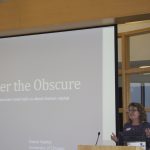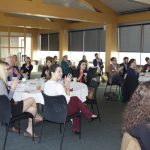On Saturday, October 29th, 2016, the Loyola University Chicago Victorian Society, a graduate student organization, hosted professors and graduate students from a variety of Chicago institutions, while others traveled to Lake Shore Campus from other states and countries. Generously sponsored by the Graduate School, the Department of English, and Dr. Paul Eggert, Martin J. Svaglic Chair of Textual Studies, LUCVS’s inaugural day conference “Past and Present: New Directions in Victorian Studies” focused firstly on new interpretations of Victorian investment in establishing the historical importance of the past and future significance of developments in their own time. Secondly, scholars grappled with how certain aspects of Victorian life and culture are historicized in the present day, specifically querying as to what directions the field of Victorian Studies is currently taking in a variety of focalizations. Thirdly, readings of the Victorian period provoked examination of the reasons behind the development of contemporary interpretative lenses.
After a beautiful sunrise and donut and coffee breakfast at 8am, Dr. Patricia Mooney-Melvin, Interim Dean of the Graduate School, started off the conference by asserting that historical and literary periods alike are marked and defined by technological advances and connections that have never been made before. Dr. Melissa Bradshaw of the Writing Center Program introduced academics Dr. Anna Kornbluh (University of Illinois at Chicago) and Dr. Benjamin Morgan (University of Chicago) both founding members of the V21 Collective, an organization described as being devoted to defetishizing the archival and resisting the genealogical trajectory of historical study common in contemporary Victorian Studies. Kornbluh and Morgan gave a joint presentation for the morning plenary, a talk that anticipated and foregrounded some of the major themes for the day. Both papers responded to the need to move beyond positivist historicism in Victorian studies. They suggested that a renewed study of form/formalism and a kind of “presentism”—that does not reduce literature and the past to a mere instrument—might offer possible avenues for moving forward.
Panel 1: “Realism” moderated by Grace Stevens, investigated how realism appeared in various forms within famous Victorian novels, emphasizing the contrasting portrayal of objects of production and ephemera in 20th-21st century literature. Corbin Hiday, (University of Illinois at Chicago) detailed how realism evidences as production in George Eliot’s Silas Marner (1861) and Tom McCarthy’s Remainder (2005). He stated that the two novels represent a convergence across historical periodization and contain the “coexistence of several modes of production,” while also providing insight into specific historical economic epochs, from weaving and an artisanal, barter impulse amidst the rise of industrialization to financialization and speculative real-estate capitalism. Benjamin D. O’Dell, (University of Illinois at Chicago – Urbana-Champaign) claimed that Victorian authors routinely blend pastoral and realist modes of representation in the production of imaginative literary hybrids, defamiliarizing popular images of England’s rural history by positioning their work as a corrective to the distorted images of nostalgic and sentimental pastoral art and literature. In particular, he cited the obsessive time-keeping and uneven pacing of George Eliot’s Adam Bede (1839) as creating a culturally sensitive narrative temporality that advances Eliot’s belief in the historic nature of rural experience. The final speaker, Jessica R. Valdez, (University of Hong Kong) explained that while Victorians valorized historical modes of thinking, they also expressed deep-seated anxieties about ephemeral texts. She propounded further on the theme, saying that despite such misgivings, many Victorian novels develop realist form through representing ephemeral texts, specifically newspapers and their formal tensions; often realist novels incorporate ephemeral texts as a means to work through a “distinct form-problem.”
Next, Panel 2: “Labor and Dickens,” moderated by Brett Beasley, focused on Charles Dickens’s use of narrative length, timeframe, and metaphorical imagery to form the landscape of his novels. Looking at Dickens’s Bleak House (1853) and Thomas Pynchon’s Gravity’s Rainbow (1973), Robert Ryan (University of Illinois at Chicago) argued that both authors similarly allow great passages of time to occur in the space of one paragraph. He posited that reading the massive, quasi-encyclopedic arrangements of both works produces a theory of the novel that stands opposed to the received practices of periodization and nationalization, all while remaining attentive to both temporal and cultural particularity. Lydia Craig (Loyola University Chicago) provided a close reading of how the water, mist, and fire work as environmental signifiers in Dickens’s Great Expectations (1861) to enact a metaphor of class warfare. Craig explained that, accordingly, mist and rain occupy a subtle, fluctuating position in relation to water and fire, as Pip, the narrator, construes evaporation imagery depending on his changing perspective of the middle class it exemplifies, and his own social self-worth.
After lunch and conversation, Panel 3: “History,” moderated by Mary Harmon examined obscure Victorian perspectives on history, as evident in adult and children’s books from the period. Robert C. Petersen (Middle Tennessee State University) revealed that the factual and anecdotal content of Agnes and Elizabeth Strickland’s eight volume work Lives of the Queens of England (1850-1859) and other works reveal the female historians’ archival methods as significantly anticipating twentieth and twenty-first century attitudes towards accurate information gathering. Peterson also claimed that descriptions of the queens themselves resisted contemporary codes and behaviors expected of women. Laura Merrell (Indiana University) described Maria Calcott’s Little Arthur’s History of England (1835) as being possibly written originally for one child as a gift and then published as a manuscript for more readers, though the details of its publication remain uncertain. Merrell argued that the book claimed to be a comprehensive if simple history of England that could prepare young students for more advanced history and consequently stayed in print for decades. She also pointed out that the realm of children’s literature was a more acceptable place for a woman to write about history but that this does not mean that we should ignore the kinds of claims Calcott made in this work.
The last panel of the day, Panel 4: “Art History” moderated by Emily Datskou, focused on Victorian attitudes to establishing the language, meaning, and form of art in their own period. Lindsay Wells (University of Wisconsin-Madison) gave a presentation on the obscure work The Flower Book (1905) by Edward Burne-Jones. She claimed that while Victorians assigned particular sentimental and emotional meanings to certain flowers, Burne-Jones often selected his own meanings based on his own preferences, as evidenced in the self-referential pattern of the book’s thirty-eight watercolor illustrations inspired by each flower’s name. Jeffrey C. Kessler (Indiana University) detailed the pioneering work of Vernon Lee (Violet Paget) in the field of historical aesthetics, examining how she uses the discourse of historical criticism for artistic means in her imaginary portrait “An Eighteenth Century Singer” (1891). Noting that Lee presents her readers with a fictional virtuoso singer, doing so as if the text was piece of historical criticism, Kessler claimed Lee’s imaginary portraits encourage readers to imagine the past beyond the historical constraints of the present. In the final presentation of the panel, Brandiann Molby (Loyola University Chicago) spoke on the visual ethics of Victorian art interpretation, which is characterized by a particular visual ethics Molby termed “right seeing,” focusing particularly on the work of Ford Maddox Brown.
Dr. Micael Clarke (Associate Professor of English) introduced the keynote speaker Dr. Elaine Hadley, (University of Chicago). Clarke applauded the dedication Hadley has shown to guiding students towards a self-aware approach both to education and developing their own future careers in teaching and other fields. Hadley spoke on theories of human capital and its relationship to contemporary economics, citing the work of Gary Becker in particular. She contrasted the economics of human capital, which insists that self-investment results in a return on said investment, with the economics of higher education, which historically insists that education is its own reward even exclusive of further earning potential. Hadley claimed that this is a false dichotomy, as higher education and liberal arts are retreating into the intangible benefit theory despite the increasing job-training emphasis on college degrees in the university at large. Acknowledging that there are no easy answers to this issue, Hadley concluded by generally referencing the problem as it appears in English and/or Victorian studies.
An evening wine and cheese reception followed Dr. Hadley’s talk at which much mirth and lively conversation was had before the day conference concluded. LUCVS would like to thank all participants and LUCVS members who came together to arrange this event, particularly our guest speakers, members, sponsors, and Dr. Melissa Bradshaw and Dr. Micael Clarke for their unfailing encouragement and helpful advice on all sorts of matters. We look forward to announcing next year’s theme soon on our website: http://lucvictoriansociety.wixsite.com/lucvs/about-lucvs










